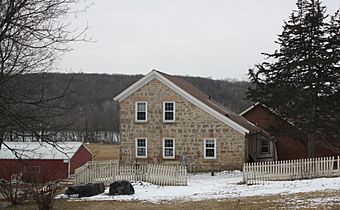Frederick Schumann Farmstead facts for kids
Quick facts for kids |
|
|
Frederick Schumann Farmstead
|
|

Frederick Schumann Farmstead
|
|
| Location | 8313 WI 19, Berry, Wisconsin |
|---|---|
| Area | 2 acres (0.81 ha) |
| Built | 1878 |
| Architect | Frederick Schumann |
| Architectural style | Mid 19th Century Revival |
| NRHP reference No. | 93001426 |
| Added to NRHP | December 10, 1993 |
The Frederick Schumann Farmstead is a really old stone farmhouse in Berry, Wisconsin. It was built way back in 1878 by a German immigrant family. This unique house has a special "saltbox" shape. Because it's so well-preserved and important, it was added to the National Register of Historic Places in 1993.
Contents
A New Life in America
Frederick Schumann was born in Saxony, Germany in 1832. When he was 18, his parents and eight siblings decided to move to America. They sold their farm and sailed across the ocean.
In 1850, the Schumann family arrived in Wisconsin. They first stayed with relatives near Springfield Corners. Soon after, they bought 80 acres of land in a beautiful valley. This land was along the road from Madison to Sauk City. Indian Lake was behind their new farm. When they arrived, the area was still very new, with only 24 voters in the whole township. Part of their farm even had tree stumps left from logging.
Frederick's Own Farm
In 1854, Frederick bought 80 acres of land next to his parents' farm. This is the land where the historic house stands today. The next year, he married Susanna Zimmerman. They started their own family.
After serving in the Civil War, Frederick continued to farm. By 1873, his farm had grown to 140 acres. Frederick was well-respected by his neighbors. In 1876, they chose him to be the president of the new Berry Mutual Fire Insurance Company. He also became a member of its board of directors.
Building the Family Home
By 1877, Frederick and Susanna had eleven children! They decided they needed a bigger house. Frederick was very skilled with wood and tools. People say he built a lot of the new house himself.
The house was finished in 1878. It has a special "saltbox" shape. This means the front of the house is two stories tall. But the roof in the back slopes all the way down to a one-story wall. This style was more common in early New England than in Wisconsin.
The walls are made of thick limestone rubble, about 18 inches wide. The stone was carefully covered with mortar to make it look like neat blocks. Above the front door, a stone lintel (a beam over a doorway) has "F. S. 1878" carved into it. The roof is covered with thin cedar shakes, which are like old-fashioned wooden shingles.
Inside the House
When you walk through the front door, you enter the living room. The three windows in this room have wooden trim that goes all the way down to the floor. This makes them look like built-in bookshelves. Most of the floors are made of unpainted pine boards.
The back rooms include a dining room and a kitchen. Upstairs, you'll find the bedrooms. The area under the sloped back roof was an unfinished sleeping space. It was used by some of the Schumanns' fifteen children!
New Owners and Restoration
Susanna Schumann passed away in 1892. In 1894, Frederick sold the farm to his son, Gustave. Frederick then moved to Mazomanie. In 1901, a neighbor named Michael Kelter bought the farm.
By 1905, a wooden summer kitchen was added off the dining room. It had a small open porch next to it. Kelter ran a dairy farm. He had many farm buildings south of the house, like a barn, silo, and chicken coop.
In 1965, John Street bought the farm. He was a professor at UW-Madison. He started to restore the old house. He replastered the inside walls. He also replaced the old summer kitchen with a similar one-story addition.
Dr. Street loved the farm very much. He worked hard to fix it up. He moved into the house in 1966 and lived there for over 30 years. With help from the Wisconsin Historic Society, he got the house listed on the National Register of Historic Places. In 1974, he sold part of his farm, including the lake property, to Dane County. This land is now called Indian Lake County Park.

